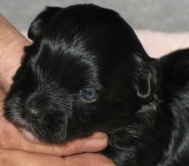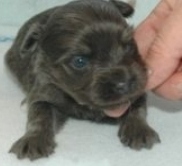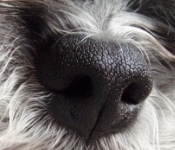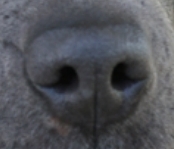
POINTS OF CONFUSION - Silver vs. Blue
There is enormous confusion between these two. One of the biggest contributors to confusion is that many people persist in attaching the "blue" label to the black dog that has silvered to charcoal or dark silver. Others use it to identify the Havanese which is a dilute colour. You may hear some differentiate between the two by saying "black turned blue" and "blue born blue". On Rainbow, we use the term blue to identify the dilute dog only.
Note: There are genetic tests available to determine whether or not a dog carries the dilution gene.
Silver Blue


Silver vs. Blue
As adults, at first glance, silver and blue Havanese can look very similar. You may have to look a little more closely. There are obvious differences at many stages of life. You will be predominantly looking at three things, the colour of the body coat, the colour of the nose pigment, and the colour of the eyes.
Silver Blue


As a puppy
A black Havanese is born black. If he carries the silvering gene, his coat colour will progressively change as he matures, but at birth, he cannot be distinguished from a black puppy. The Blue Havanese is born a silvery, blue grey colour. The coat colour is dilute right from birth. Nose and eye colour are not reliable on the young puppy. Some puppies have nose pigment right from birth but many do not. Eye colour is not accurate at this age as all puppies have deep blue eyes when the eyes first open. It can take 8-12 weeks for the eye colour to settle. Birth colour is a good start but it may be several weeks before you can be sure.
As an adult
The colour of the body coat cannot be used to tell the difference between silver and blue as the adult coat colours can be very similar and many shades of grey overlap between the two. With adults, you will have to rely on nose pigment and eye colour. The silver Havanese has black pigment and medium/dark brown eyes and the blue (dilute black) Havanese has grey pigment and lighter eyes. When in doubt, look at the nose pigment.
NEXT ... Charcoal vs. Silver

